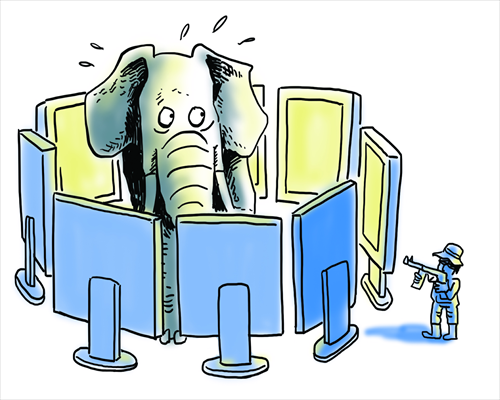Online herds shelter vulnerable elephants

Illustration: Liu Rui/GT
On April 30, Kenya took the bold step of incinerating its entire stockpile of confiscated elephant ivory that might have otherwise ended up as expensive trinkets, carvings and jewelry. Tusks from 6,500 dead elephants burned in pyres throughout the night, and out of the ashes rose an unequivocal message to the international community: Elephants are worth more alive than dead.
Despite the 1989 international ban, the current ivory poaching crisis has been raging since 2008 when a one-off sale was authorized to markets in East Asia, where growing affluence fueled unprecedented consumer demand. Nations with legal ivory trades, including the US, have provided convenient cover for illegal ivory sales from recently poached elephants.
This black market commerce has decimated elephant populations: an estimated 100,000 elephants were killed for their ivory between 2010 and 2012, and at least 65 percent of Africa's forest elephants were poached during 2002-13.
But if there's good news in these dire times for elephants, it's that we've beaten back the ivory trade before, and this time we have new weapons to defeat it for good. In addition to the hundreds of millions in pro bono media placement and airtime provided by the government and our media partners in China for our TV, video and billboard messages, social media is another powerful tool for raising awareness. If utilized smartly, it can serve an invaluable role in fighting the $20-billion global illegal wildlife trade.
At WildAid, we've found two elements are keys to achieving maximum reach and inspiring users on social media. The first is a roster of iconic ambassadors, who care about the cause and are willing to engage their legions of fans on Twitter, Instagram, Facebook and Snapchat. For example, when we launched the #JoinTheHerd campaign in February, a core group of WildAid ambassadors, including Leonardo DiCaprio, Lupita Nyong'o, Ian Somerhalder, Yao Ming and Maggie Q, committed to using their online platforms to communicate the campaign's goal that 2016 can be a turning point for elephants, the year when more are born than killed by poachers. In the Chinese mainland, Vietnam, Hong Kong, Tanzania and South Africa, our regional celebrities also promoted the campaign. So far, over 100,000 people have joined, and tens of millions of social media users have seen their messages in support of elephant conservation.
The second key element is a social media audience who are equally eager to raise much-needed awareness. Their engagement highlights the urgency of the poaching crisis among their networks and builds more public support for needed changes such as strengthened enforcement and trade bans. Millennials in particular have been crucial to the #JoinTheHerd movement as well as other social media-driven movements for wildlife and other causes. More than half of all "herd members" are age 25 or younger.
Of course, social media posts, likes and retweets do not create change by themselves. But in recent years, awareness campaigns in Asia that incorporate social media as a key strategy have been more effective than others. In China, a 2015 WildAid study found that public awareness of the African elephant poaching crisis increased by 50 percent in just two years, while a vast majority of the Chinese public now supports government action to end ivory sales. Such favorable public opinion may have demonstrated strongly supportive public sentiment ahead of the joint commitment announced last fall by US President Barack Obama and President Xi Jinping of China to end the ivory markets in their respective nations.
Last week, young leaders from around the world gathered in Arizona at Biosphere 2, the world's largest earth science laboratory, for the One Young World Environment Summit, to develop solutions that address environmental issues threatening our planet's future.
Time and again, we've seen how important younger generations are in persuading society against buying ivory and other products that decimate wildlife populations and rob impoverished African communities of tourism revenue that elephants, rhinos and other wildlife can attract. That's why convening passionate and talented minds together with world experts in such a forum is a perfect example of how we can help launch forward this movement. As never before, young people have the passion, knowledge and social tools to help wildlife and our environment on a global scale.
The author is managing director of WildAid and counselor at the One Young World Environment Summit, taking place from Thursday to Saturday in Arizona. opinion@globaltimes.com.cn